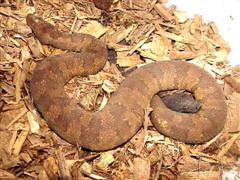Boa - Viper
Pacific Ground Boa, Papuan Ground Viper, Viper Boa, New Guinea Boa, Pacific Boa Scientific Name: Candoia aspera
Wed, 30th April, 2025 - 8:49 am GMT
Sponsor Ads:

Alternative Name
Pacific Ground Boa, Papuan Ground Viper, Viper Boa, New Guinea Boa, Pacific Boa Scientific Name: Candoia asperaBasic Info
Male and female Viper Boas are easy to distinguish visually. The males have spurs on either side of their vents, and the females have none. This is even apparent in babies. Viper Boas may differ greatly in both color and pattern. So the description below is more of a guide than a rule. Most Viper Boas range from black to gold. They are seen in varying shades of brown, grey, orange and rust. Brown is the most common color, however, and the most common pattern consists of striped spots that run horizontally along the length of the snake. The average Viper Boa grows between 2 and 3 feet in length at maturity.
Health
The Viper Boa is relatively easy to care for in captivity. The main problem with this snake stems from wild caught species, which tend to carry disease. Once they have been treated for any parasites or infections they are usually quite easy to maintain. Many wild caught individuals are reported to be problem feeders, and this often stems from sickness. This species loves to bathe, and it should be given a water bowl that is ample size for soaking. It is not uncommon to find them soaking for days at a time. This species will even breed in water. Viper Boas should be fed rodents, and it is reported that they prefer fuzzy rats to adult mice. Though fuzzy rats are not the preferred died, since adult mice have more calcium than fuzzy rats, and therefore provide a more balanced diet. Most Viper Boas only need to be fed every 3 to 4 weeks, which is significantly less often than some other boids. The best rule of thumb, however, is to feed when they are hungry. Enclosures should be kept between 80 and 85 degrees Fahrenheit year round. Since this is a tropical species, humidity levels should be kept high, between 50 and 80 percent. The Viper Boa needs a thick layer of substrate in which to bury itself. This species likes to hide, and should be provided plenty of hiding places. Breeding The Viper Boa is a livebearer. The presence of multiple males is usually required to help induce the female into breeding. Though there are exceptions. Additionally it is important to provide a winter cool down period of 6 to 8 weeks prior to breeding. Daytime temperatures should be approximately 80 degrees Fahrenheit while nigh time temperatures should be lowered between 60 and 65 degrees. After breeding and incubation the Viper Boa will usually give birth to 5 to 20 babies. Babies and juvenile Viper Boas should be fed more often than adults. They usually require feeding every 10 to 14 days.Habitat
N/ABehavior
The Viper Boa is so named because it often bears a striking resemblance to the Death Adder, which is a highly venomous snake. Oddly, this species can vary in appearance from one individual to the next, which may account for its other common names, which include; Pacific Ground Boa, Papuan Ground Viper, New Guinea Boa, and Pacific Boa. The Viper Boa is a member of the genus Candoia. This genus is comprised of at least three different species, and perhaps as many as eight. Most of the members of the genus Candoia are collectively referred to as Pacific Boas. The Viper Boa is unique because it is the smallest and the fattest member of this genus. The Viper Boa is a nocturnal species, and is therefore usually only active at night. This species is not very common in captivity, and for this reason they may be difficult to find. Viper Boas are reported to be more aggressive than some other Pacific Boas, though this varies significantly from individual to individual. Wild caught individuals may be the cause of this reputation, since most are underfed upon arrival and usually have a bad disposition because of it. Once they are fed they generally become much more docile. In the wild this species prefers to spend most of its time on the forest floor under logs and leaves.Origin
Indo-PacificHistory
The Viper Boa is native to the Islands of the South Pacific. This is true of all Pacific Boas. No Pacific Boa is native to the mainland. They are currently endangered in the natural habitat, which includes Papua New Guinea, Irian Jaya and multiple Indonesian islands. Many Viper Boas are killed because they resemble poisonous snakes.Common Foods
N/ASponsor Ads:
Obscenity is whatever gives a judge an erection. --Anonymous
Boa - Viper
Coded by: BGID® | ALL RIGHTS RESERVED Copyright © 2000-2025
Disclaimer | Privacy | Report Errors / Contact | Credits








 President of the United States of America - Real Estate mogul, Pageant owner and now one of the most controversial men in political history.
President of the United States of America - Real Estate mogul, Pageant owner and now one of the most controversial men in political history.  Politician, US Vice President and President of the USA - Joseph Robinette Biden Jr.
Politician, US Vice President and President of the USA - Joseph Robinette Biden Jr.  versus
versus  Russia: 'The Evil Empire'? Are they all that bad or is it just the USA trying to portray Russia as bad because they are a world power with land bigger and a society very different from the USA ideal?
Russia: 'The Evil Empire'? Are they all that bad or is it just the USA trying to portray Russia as bad because they are a world power with land bigger and a society very different from the USA ideal?  Global warming has been in and out as the "latest" hot topic for many years. It is, according to modern scientists, the result of man-made industrial pollutants, clearing forested areas, agriculture, etc. But now they are thinking it started way before the Industrial Revolution...
Global warming has been in and out as the "latest" hot topic for many years. It is, according to modern scientists, the result of man-made industrial pollutants, clearing forested areas, agriculture, etc. But now they are thinking it started way before the Industrial Revolution... 
 Corona virus
Corona virus 
 Users with wide screen monitors can benefit from more content on every page.
Users with wide screen monitors can benefit from more content on every page.